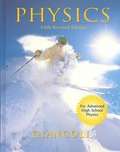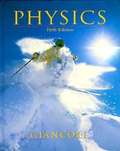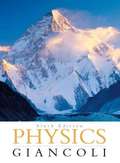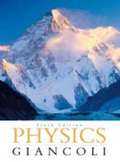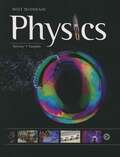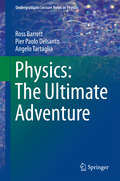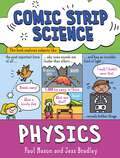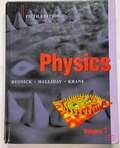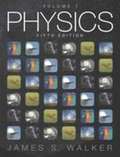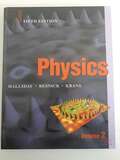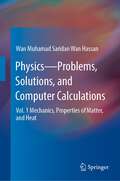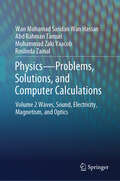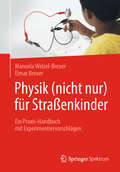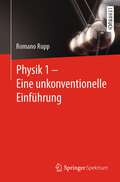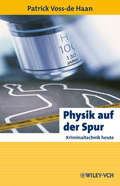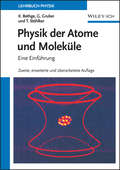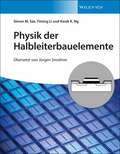- Table View
- List View
Physics: Principles and Problems, Laboratory Manual, Student Edition
by Glencoe Mcgraw-HillThe Laboratory Manual contains 53 experiments for the beginning student of physics. The experiments illustrate the concepts found in this introductory course. Both qualitative and quantitative experiments are included, requiring manipulation of apparatus, observation, and collection of data. The experiments are designed to help you utilize the processes of science to interpret data and draw conclusions.
Physics: Principles and Problems, Laboratory Manual, Student Edition
by Glencoe Mcgraw-HillThe Laboratory Manual contains 53 experiments for the beginning student of physics. The experiments illustrate the concepts found in this introductory course. Both qualitative and quantitative experiments are included, requiring manipulation of apparatus, observation, and collection of data. The experiments are designed to help you utilize the processes of science to interpret data and draw conclusions.
Physics: Principles with Applications
by Douglas C. Giancoli Randall D. KnightPhysics: Principles with Applications (Fourth Custom Edition for SUNY Binghamton)
Physics: Principles with Applications
by Douglas GiancoliThe ultimate aim is to give students a thorough understanding of the basic concepts of physics in all its aspects, from mechanics to modern physics. A second objective is to show students how useful physics is in their own everyday lives and in their future professions by means of interesting applications to biology, medicine, architecture, and more.
Physics: Principles with Applications (5th Revised Edition)
by Douglas C. GiancoliPhysics textbook for teens.
Physics: Principles with Applications (5th edition)
by Douglas C. GiancoliThis algebra-based physics text contains many intriguing applications, including airbags, bungee jumping, photocopiers, highway mirages, and computer hard drives. The pedagogy has been updated to reflect new research on how students learn. Consequently, chapters now include two or three conceptual examples--each a sort of brief Socratic question and answer. Estimating examples show how to make order-of-magnitude estimates even when the data are scarce.
Physics: Principles with Applications (6th Edition, Updated)
by Douglas C. GiancoliThis book is written for students to give a thorough understanding of the basic concepts of physics in all its aspects, from mechanics to modern physics. It aims to explain physics in a readable and interesting manner that is accessible and clear, and to teach students by anticipating their needs and difficulties without oversimplifying.
Physics: Principles with Applications (6th edition)
by Douglas C. GiancoliThis algebra-based physics text contains many intriguing applications, including airbags, bungee jumping, photocopiers, highway mirages, and computer hard drives. The pedagogy has been updated to reflect new research on how students learn. Consequently, chapters now include two or three conceptual examples--each a sort of brief Socratic question and answer. Estimating examples show how to make order-of-magnitude estimates even when the data are scarce.
Physics: Principles with Applications (6th edition)
by Douglas C. GiancoliThis algebra-based physics text contains many intriguing applications, including airbags, bungee jumping, photocopiers, highway mirages, and computer hard drives. The pedagogy has been updated to reflect new research on how students learn. Consequently, chapters now include two or three conceptual examples--each a sort of brief Socratic question and answer. Estimating examples show how to make order-of-magnitude estimates even when the data are scarce.
Physics: The Foundational Science
by Sean Vinaja Ed RickardThis book makes physics understandable and provides thorough and detailed explanations with a touch of humor, which helps students grasp the most perplexing questions. Wherever possible, the principles of physics are illustrated by everyday experience and practical devices. Students are shown how the many kinds of technology from the camera to the car actually function. Numerous illustrative problems are solved in detail. <p><p>This textbook can play an important role in showing students the harmony between scientific knowledge and Christian belief. The text is firmly grounded on the view that we live in a God-created world governed by laws discoverable by reverent scientific inquiry. Interspersed throughout the text are biographies of great physicists who were also Bible-believing Christians.
Physics: The Ultimate Adventure
by Ross Barrett Pier Paolo Delsanto Angelo TartagliaThisbook explains - in simple terms and with almost no mathematics - the physics behindrecent and glamorous discoveries in Cosmology, Quantum Mechanics, ElementaryParticles (e. g. Higgs bosons) and Complexity Theory. En route it delves intothe historical landmarks and revolutions that brought about our currentunderstanding of the universe. Thebook is written mainly for those with little scientific background, bothcollege students and lay readers alike, who are curious about the world ofmodern physics. Unsolved problems are highlighted and the philosophicalimplications of the sometimes astounding modern discoveries are discussed. Along the way the reader gains an insight into the mindset and methodology of aphysicist.
Physics: The science of forces, energy and simple machines (Comic Strip Science #3)
by Paul MasonComic Strip Physics makes learning about the science behind forces, energy and simple machines fun! Each spread in this series features a short, funny comic strip that explains a process or aspect of science. Around the strip, diagrams and panels give further information on the topic. They are a fantastic way to engage children aged 8 plus with science.The illustrator, Jess Bradey, is winner of the 2021 Blue Peter Award for Best Non-Fiction for A Day in the Life of a Poo, Gnu and You and also writes and draws for The Phoneix Comic. Titles in the series: Biology, Chemistry, Earth and Space, Physics.
Physics: Volume 1
by David Halliday Robert Resnick Kenneth S. KraneWritten for the full year or three term Calculus-based University Physics course for science and engineering majors, the publication of the first edition of Physics in 1960 launched the modern era of Physics textbooks. It was a new paradigm at the time and continues to be the dominant model for all texts. Physics is the most realistic option for schools looking to teach a more demanding course.
Physics: Volume 1 (Fifth Edition)
by James S. WalkerJames Walker's Physics provides students with a solid conceptual understanding of physics that can be expressed quantitatively and applied to the world around them. Instructors and students praise Walker's Physics for its friendly voice, the author's talent for making complex concepts understandable, an inviting art program, and the range of excellent homework problems and example-types that provide guidance with problem solving. <P><P>The Fifth Edition, Volume 1 (Chapters 1-18) includes new "just-in-time" learning aids such as "Big Ideas" to quickly orient students to the overarching principles of each chapter, new Real-World Physics and Biological applications, and a wealth of problem-solving support features to coach students through the process of applying logic and reasoning to problem solving.
Physics: Volume 2
by David Halliday Robert Resnick Kenneth S. KraneWritten for the full year or three term Calculus-based University Physics course for science and engineering majors, the publication of the first edition of Physics in 1960 launched the modern era of Physics textbooks. It was a new paradigm at the time and continues to be the dominant model for all texts. Physics is the most realistic option for schools looking to teach a more demanding course. The entirety of Volume 2 of the 5th edition has been edited to clarify conceptual development in light of recent findings of physics education research. End-of-chapter problem sets are thoroughly over-hauled, new problems are added, outdated references are deleted, and new short-answer conceptual questions are added.
Physics: the Physical Setting 2012 Prentice Hall Brief Review for the New York Regents Exam
by Bernadine Hladik CookThis book is designed to enhance review of the concepts, skills, and applications of the physical setting/physics core curriculum that may be tested on the physical setting/physics regents examination.
Physics—Problems, Solutions, and Computer Calculations: Vol. 1 Mechanics, Properties of Matter, and Heat
by Wan Muhamad Wan HassanKnowledge of and skill in physics are essential foundations for studies in science and engineering. This book offers students an introduction to the basic concepts and principles of physics. It covers various topics specifically related to physical mechanics, the properties of matter, and heat. Each chapter begins with a summary of concepts, principles, definitions, and formulae to be discussed, as well as ending with problems and solutions that illustrate the specific topic. Steps are detailed to help build reasoning and understanding. There are 300 worked problems and 100 exercises in the book, as well as 306 figures to help the reader visualize the processes being addressed. Computer calculations and solutions are carried out using wxMaxima to give insight and help build computational skills. The book is aimed at first-year undergraduate students studying introductory physics, and would also be useful for physics teachers in their instruction, particularly the exercises at the end of each chapter.
Physics—Problems, Solutions, and Computer Calculations: Volume 2 Waves, Sound, Electricity, Magnetism, and Optics
by Wan Muhamad Wan Hassan Abd Rahman Tamuri Muhammad Zaki Yaacob Roslinda ZainalKnowledge of and skill in physics are essential foundations for studies in science and engineering. This book offers students an introduction to the basic concepts and principles of physics. It covers various topics specifically related to waves, sound, electricity, magnetism, and optics. Each chapter begins with a summary of concepts, principles, definitions, and formulae to be discussed, as well as ending with problems and solutions that illustrate the specific topic. Steps are detailed to help build reasoning and understanding. There are 250 worked problems and 100 exercises in the book, as well as 280 figures to help the reader visualize the processes being addressed. Computer calculations and solutions are carried out using wxMaxima to give insight and help build computational skills. The book is aimed at first-year undergraduate students studying introductory physics, and would also be useful for physics teachers in their instruction, particularly the exercises at the end of each chapter.
Physik (nicht nur) für Straßenkinder
by Manuela Welzel-Breuer Elmar BreuerDas vorliegende Handbuch ist für Menschen geschrieben, die Spaß am Experimentieren haben, andere für physikalische Phänomene begeistern wollen und nach sorgfältig erstellten und erprobten Anleitungen suchen. Die Autoren zeigen anhand eigener Erfahrungen, wie man Physik unter Verwendung einfacher Materialien vermitteln kann – nicht nur Straßenkindern. Sie beschreiben übersichtlich und systematisch Reihen erprobter Experimentiervorschläge aus den Bereichen der Elektrizitätslehre und Optik. Sie nutzen dabei einfach zu beschaffende Materialien und analysieren die Experimente im Hinblick auf Lernmöglichkeiten und Sprachanlässe. Das Buch entstand aus der Bildungsarbeit mit Kindern und Jugendlichen in schwierigen Lebenslagen in Kolumbien und in Deutschland. Es gibt eine Einführung in Ursachen und Randbedingungen des Lebens auf der Straße und liefert Vorschläge methodischer Zugänge und Möglichkeiten, naturwissenschaftliche Bildung beispielsweise für Straßenkinder oder Flüchtlinge zu realisieren. Die Autoren Prof. Dr. Manuela Welzel-Breuer ist Professorin für Physik und ihre Didaktik an der Pädagogischen Hochschule Heidelberg und betreut verschiedene Forschungsprojekte zum Lehren und Lernen von Physik und Naturwissenschaften auf der Grundlage eigener empirischer Lernprozessforschung und Schulpraxis. Dr. Elmar Breuer ist Lehrer für Mathematik, Physik, Informatik und NWT im Gymnasium Englisches Institut Heidelberg. Parallel ist er als Lehrbuchautor aktiv und übernimmt regelmäßig Lehraufträge an der Pädagogischen Hochschule Heidelberg.
Physik 1 – Eine unkonventionelle Einführung
by Romano RuppDieses Lehrbuch eröffnet einen alternativen Zugang zur Physik und bietet eine konsistente Einführung in die relevanten Themen der klassischen Physik. Anders als in vielen Physikbüchern wird hier die grundlegende Methode der Physik am Beispiel einer vorläufigen Theorie des Lichtes erläutert und daran anknüpfend die Geometrische Optik und die Relativitätstheorie aufgebaut. Von den mathematischen Anforderungen stützt es sich damit auf bekanntes Schulwissen.Erst im Anschluss werden die Mechanik auf den Erhaltungsgrößen Impuls und Energie entwickelt und die wichtigsten Konzepte aus Kinematik und Dynamik bis hin zur Kontinuumsmechanik dargestellt. Von dort gelingt ein fließender Übergang in die Thermodynamik, wo mit der thermischen Energie erstmals eine nicht-mechanische Energieform eingeführt wird. Besonderes Augenmerk wird dabei von Anfang an auf die Entropie gesetzt, die als extensive Zustandsvariable der thermischen Energieform den Schlüsselbegriff der Thermodynamik darstellt.Als Nächstes werden unter den Schlagwörtern „chemische Energie“ und „elektrische Energie“ zwei weitere Beispiele für nicht-mechanische Energieformen vorgestellt. Zwei weiterführende Kapitel über Transportphänomene und Wellen runden die Darstellung ab.Die jeweiligen mathematischen Kenntnisse werden parallel zu den physikalischen Inhalten eingeführt und erweitert sowie teilweise in ergänzenden Kapiteln zusammenfassend bereitgestellt. Kürzere philosophische Betrachtungen und Histörchen aus der Physikgeschichte lockern die Darstellung auf. Insbesondere eignet sich das Buch für Studierende als Ergänzung zur Physik-Vorlesung und für Lehrende der Physik, die einen neuen Zugang für ihre Lehre suchen.
Physik auf der Spur: Kriminaltechnik heute (Erlebnis Wissenschaft)
by Patrick Voss-de HaanPatrick Voss-de Haan, Mitarbeiter des BKA und seit vielen Jahren mit naturwissenschaftlichen Anwendungen in der Kriminaltechnik befasst, legt mit diesem Werk eine spannend geschriebene und auch für Laien verständliche Einführung in Techniken, Verfahren sowie aktuelle und zukünftige Aufgaben der Kriminalitätsprävention und -bekämpfung vor. Im Zusammenspiel der verschiedensten Disziplinen - Physik, Chemie, Werkstofftechnik oder auch Psychologie - ist die Kriminaltechnik immer dann gefragt, wenn es um solide Beweisketten geht. Wichtigstes Hilfsmittel ist das Rasterelektronen-Mikroskop (REM): War der Verdächtige am Tatort? - Aufschluss kann eine Untersuchung geben, ob sich zum Beispiel Faserspuren vom Opfer an seiner Kleidung finden oder umgekehrt. War der Blinker zum Zeitpunkt des Unfalls eingeschaltet? - Hier hilft eine Betrachtung der Glühwendel. Wurde das gefundene Projektil aus dem Lauf der sichergestellten Waffe abgefeuert? - Eine vergleichende Untersuchung mit einem Projektil aus einem "Probeschuss" beantwortet diese Frage. Voss-de Haan geht in seinem Buch auf diese und zahlreiche andere Fälle ein, bei deren Aufklärung die Naturwissenschaften eine wichtige Rolle spielen. So können entfernte und überschriebene Fahrgestellnummern gestohlener Autos durch Verfahren wie Ätzen oder die so genannte Kavitationserosion wieder sichtbar gemacht werden. Und anhand der Zusammensetzung des Tonermaterials und charakteristischer Spuren auf dem Vorlagenglas lassen sich Fotokopierer "identifizieren", auf denen Erpresserschreiben vervielfältigt wurden. Das Buch zeigt, was Kriminaltechnik heute zu leisten imstande ist. Wer gerne knifflige Fälle löst, wird überrascht sein, welche Rolle die Physik dabei spielt.
Physik der Atome und Moleküle: Eine Einführung
by Klaus Bethge Thomas Stöhlker Gernot GruberDie Autoren präsentieren eine integrierte Darstellung von Atom- und Molekülphysik. Neben grundlegenden Themen wie Quantenmechanik und Statistik behandeln sie auch neuere Anwendungen, z.B. die Hochpräzisionsspektroskopie. Das bewährte didaktische Konzept der Vorauflage wurde beibehalten. Inhaltlich wurde der Band vollständig überarbeitet und aktualisiert, eine ganze Reihe neuer Kapitel sind hinzugekommen. Dass Atom- und Molekülphysik eng miteinander vernetzt sind, ist bekannt. Diese Einsicht in einem Lehrbuch umzusetzen, war das Anliegen der Autoren, als sie sich an die Arbeit zur ersten Auflage dieses Bandes machten. Und der Erfolg gab ihnen Recht. Nun liegt ihr Werk in einer völlig überarbeiten und aktualisierten Neuauflage vor. Der Band verbindet die Vermittlung von Grundlagenwissen mit der Darstellung modernster Methoden und Anwendungen. So kann sich der Leser nicht nur die "Basics" etwa in Quantenmechanik und Statistik aneignen. Denn in den neuen Kapiteln finden sich nun auch die jüngsten Erkenntnisse aus der Quantenoptik, zu Atom- und Ionenfallen, Atomen in starken Magnetfeldern und aus der Hochpräzisions-spek-troskopie. Auch die Geheimnisse der Bose-Einstein-Kondensate werden gelüftet. Am erfolgreichen didaktischen Konzept der ersten Auflage wurde nichts geändert. Alle Herleitungen werden ausführlich erklärt und durchgerechnet, schwierige Gedankengänge und komplizierte Rechnungen werden Schritt für Schritt erläutert.
Physik der Halbleiterbauelemente
by Simon M. Sze Kwok K. Ng Yiming LiPhysik der Halbleiterbauelemente Das Standardwerk zur Physik der Halbleiterbauelemente – erstmals auf Deutsch! Dieses einzigartige Buch, geschrieben von Pionieren auf dem Gebiet, behandelt sämtliche Aspekte der Physik der Halbleiterbauelemente, die zu deren Verständnis, Betrieb, Weiter- und Neuentwicklung notwendig sind. Wie das englische Original ist die deutsche Ausgabe ein äußerst nützliches Nachschlagewerk in der industrieorientierten Halbleiterforschung und eignet sich ebenfalls ausgezeichnet als Einstiegsliteratur für Studierende sowie als Unterrichtsmaterial für Vortragende. Bei der deutschen Ausgabe wurde besonderer Wert auf eine gute Lesbarkeit gelegt und daher die Übersetzung, teilweise unter Rückgriff auf die von den Autoren zitierten Originalquellen, so gestaltet, dass unnötige Anglizismen vermieden werden. Das englische Fachvokabular ist ergänzend an den entsprechenden Stellen im Text eingearbeitet, um den Leserinnen und Lesern den Gebrauch der englischsprachigen Fachliteratur zu erleichtern. Gelegentliche Anmerkungen im Text und Verweise auf weitere Originalquellen tragen zusätzlich zum besseren Verständnis der Materie bei. Als das Referenzwerk schlechthin ist der „Sze“ ein Muss für alle, die sich in Forschung, Entwicklung und Lehre mit Halbleiterbauelementen beschäftigen. Die Inhalte sind kompakt und präzise beschrieben und eignen sich perfekt für den Einstieg in das jeweilige Gebiet, komplettiert durch vertiefende Übungsbeispiele zu jedem Kapitel. Physik der Halbleiterbauelemente bietet eine unerreichte Detailfülle und ausführliche Informationen über die Physik und den Betrieb aller relevanten Halbleiterbauelemente, mit 1000 Literaturangaben, 650 technischen Illustrationen sowie 25 Tabellen mit Material- und Bauelementparametern. Aus dem Inhalt: Halbleiterphysik-Grundlagen p-n Übergänge Metall-Halbleiter-Kontakte MIS-Kondensatoren Bipolartransistoren MOSFETs Nichtflüchtige Speicher JFETs MESFETs und MODFETs Tunnel-Bauelemente IMPATT-Dioden TE- und RST-Devices Thyristoren und Leistungsbauelemente Photodetektoren und Solarzellen Sensoren

